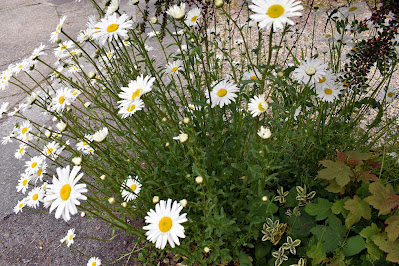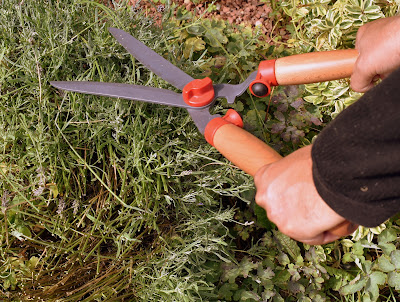I love our garden and have found that I need to change the way I garden under these conditions. Many of the plants I love to grow are not drought tolerant and while this may need to change if we have frequent droughts in the years to come, for now I want to try to keep them all alive.
However, it is also very important in a rough situation not to drain necessary water from the system so as to preserve as much as possible both inside and outside our homes.
So here are a few tips I have picked up from other gardeners and my own experience
1. Water Plants Deeply Once A Week.
Doing this is a much better approach than watering a little every day. We need the water to reach the roots not just wet the top few inches which will just evaporate in the heat anyway.
Always water either very early morning or late in the day when the sun is fading and there will be less moisture loss. Put your finger into the soil to check how far down the soil is wet.
2. Use Shade For Plants.
For plants in containers move them into the shade wherever possible. Place plants in pots under the shade of a tree or by a north-facing wall of a house or garden shed or garage. That way they will be shaded for more of the day. Group plants in pots together. Sharing space will help each other stay cooler. Also if you can place smaller pots above bigger pots any water that drips through will help to water plants below, thus saving more water.
3. Make Shade For Plants
If the containers cannot be moved into the shade try to provide them with shade. I like to use the shade of other plants, especially those who don't mind the sun so much but even an open umbrella over them, a patio umbrella or a cardbox box strategically placed will help.
4. Use Large Drip Tray Containers.
For plants that do not mind being in standing water and are in pots, put any container that holds water under the pot.
I find that these drip trays that we often use for houseplants are good to hold some water underneath our garden plants in pots, but not so much that the plants then get waterlogged. I tend to use larger sizes to hold more water.
5. Prioritise Plants For Water.
Concentrate on the plants that you know need more water such as roses and also plants that look dry, dropping leaves or droopy. Prioritise plants in pots and perennials over annuals. Plants that are more suited to Mediterranean or hotter environments and those like Bottlebrush, Lavender, Thyme and Rosemary will cope better than roses and new cuttings or young plants. I rarely water any existing shrubs or trees in the ground, the hope is that their deep roots will seek water low down.
6. Leave The Lawn.
Do not water the lawn- most lawns are robust and will recover once we start getting rain. Also, our lawn is now mainly brown and not growing at all so there is no point trying to mow it. When autumn comes we will feed it and take care of it but for now the best thing is to leave it.
7. Use Watering Spikes.
Use some of these water spikes devices. They release water slowly into the pot. If you make a hole first deep into the pot. Connect a water bottle to the spike, turn upside down and very gently insert the spike into the hole so that you do not break it or injure any roots. The water will seep to where the roots are rather than wasting water at the top of the pot. I use them for when we go on holiday and I prefer the terracotta ones, although you do need to take more care of them being more fragile, they do a better job in my opinion. Now they are valuable for simply giving a gentle water source. A litre bottle should last about a week to ten days.
8. Stop Feeding Plants.
Do not feed plants as this encourages growth. I am finding that many of my plants are going to seed much more quickly and some are already adopting their autumn colours. I think this may be a way of ensuring their survival. If they are under stress they want to make seed quickly in case they die and by losing their leaves they need less energy.
9. Use Rain Barrels Or Water Butts.
Install a Water Butt or Rain Barrel to prepare for any future drought. The water butt will fill up when we do have rain in winter and then can be used in a summer heatwave or drought when water is in short supply.
10. Use "Grey Water" To Water Some Plants.
Watering plants If there is a ban on using hosepipes or using house water can be difficult. Instead, we can use water from handwashing clothes or washing up water on our plants. Always allow the water to cool down first though.
However, never use this kind of "grey water" on fruit, vegetable or herb plants. Do be careful though as some plants may be sensitive to chemicals in your grey water. This is another reason a water butt will be useful.
People say you can always replace plants but they are expensive and this is not always possible when a plant has a special memory or was gifted to you by a loved one.
It breaks my heart to see them suffering in the heat and drought so if I can do these small things to help them I certainly will. So far I have to say they are doing remarkably well and I do feel while I have had one or two losses that most will come through this and recover once we get some good rain.
It may be in the future that we will have to adapt our gardens even further and grow more drought-resistant plants but we will see. So for now I will do what I can to keep them alive while keeping the drain on the water systems to a minimum.
In addition, while caring for our plants never forget the wildlife and do leave out a shallow bowl with a few pebbles and water in it to help hedgehogs, bees and other insects get through the drought and a birdbath to help the birds care for their feathers, bathe and drink.
As a final thought and this may be unpopular among people who love the sunshine and hot weather, I am hoping for lots of gentle steady rain very soon!!




















